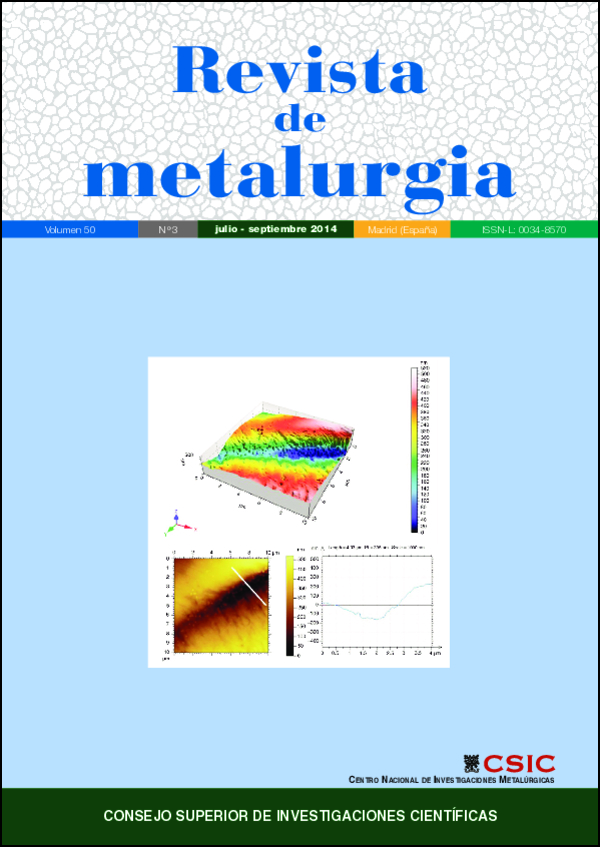Efecto del envejecimiento natural sobre la microestructura, propiedades mecánicas, resistencia a corrosión y fractura en uniones soldadas de acero para tubería API5L X52
DOI:
https://doi.org/10.3989/revmetalm.024Palabras clave:
Acero API5L X52, Degradación, Engrosamiento, Envejecimiento natural, ZACResumen
Se realizó un estudio de caracterización para analizar cómo la microestructura afecta a las propiedades mecánicas, corrosión y fractura de la zona afectada por calor (ZAC), soldadura y metal base para tubería envejecida naturalmente durante 21 años a 30 °C. Los resultados indicaron que las microestructuras presentaron daño y consecuentemente reducción en propiedades mecánicas, como consecuencia del envejecimiento por servicio. El estudio mediante MEB mostró que el metal base presenta grano ferrítico grueso. La prueba de tensión indicó que las microestructuras mostraron fluencia discontinua. La mayor resistencia a la tracción se presentó en la soldadura, la cual alcanzó menor energía de impacto en comparación con la ZAC y metal base asociado con fractura frágil por clivaje transgranular. La degradación de las propriedades está en relación con el engrosamiento de nanocarburos observados a través del análisis de imágenes por MET, lo que se confirmó mediante fractografía por MEB de superfícies de fractura bajo tensión e impacto. La soldadura alcanzó la mayor densidad de microhuecos y la mayor susceptibilidad a la corrosión en un medio conteniendo H2S que cuando se compara con la ZAC y metal base.
Descargas
Citas
API 5L (2008). Specification for Line Pipe, 44th Ed., American Petroleum Institute, Washington D.C., USA, pp. 8–17.
ASTM Standard G-102 (2004). Standard Practice for Calculation of Corrosion Rates and Related Information from Electrochemical Measurements. ASTM International, West Conshohocken, PA, USA, pp. 1–5.
ASTM Standard E-112 (2004). Standard Test Methods for Determining Average Grain Size. ASTM, West Conshohocken, PA, USA, pp. 10–12.
ASTM Standard E-384 (2005). Standard Test Method for Microindentacion Hardness of Materials. ASTM, West Conshohocken, PA, USA, pp. 1–8.
ASTM Standard E-23 (2006). Standard Test Methods for Notched Bar Impact Testing of Metallic Materials. ASTM, West Conshohocken, PA, USA, pp. 2–8.
ASTM Standard E-8M (2008). Standard Test Methods for Tension Testing of Metallic Materials. ASTM, West Conshohocken, PA, USA, pp. 7–18.
AWS A5.17 (2004). Specification for Carbon Steel Electrodes and Fluxes for Submerged Arc Welding. American Welding Society, Miami FL, USA, pp. 2–4.
Hamada, I., Yamauchi, K. (2002). Sensitization behavior of type 308 stainless steel weld metals after postweld heat treatment and low temperature aging and its relation to microstructure. Metall. Mater. Trans. A 33 (6), 1743–1754. http://dx.doi.org/10.1007/s11661-002-0183-5
Homma K., Miki C., Yang, H. (1998). Fracture toughness of cold worked and simulated heat affected structural steel. Eng. Fract. Mech. 59 (1), 17–28. http://dx.doi.org/10.1016/S0013-7944(97)00100-8
Jayan, V., Khan, Y.M., Husain, M. (2004). Coarsening of nano sized carbide particles in 2.25Cr–1Mo power plant steel after extended service. Mater. Lett. 58 (21), 2569–2573. http://dx.doi.org/10.1016/j.matlet.2004.02.051
Kotrechko, O.S., Krasowsky, Y.A., Meshkov, Y.Y., Torop, M.V. (2004). Effect of long-term service on the tensile properties and capability of pipeline steel 17GS to resist cleavage fracture. Int. J. Pres. Ves. Pip. 81 (4), 337–344. http://dx.doi.org/10.1016/j.ijpvp.2004.02.015
Krauss, G. (1990). Heat treatment and processing principles. ASM Materials, Park OH, USA, pp. 125–130.
Moon, J., Lee, Ch., Uhm, S., Lee, J. (2006). Coarsening kinetics of TiN particle in a low alloyed steel in weld HAZ: considering critical particle size. Acta Mater. 54 (4), 1053–1061. http://dx.doi.org/10.1016/j.actamat.2005.10.037
NACE ID-182 (1995). Wheel Test Method Used for Evaluation of Film-Persistent Corrosion Inhibitors for Oilfield Applications. NACE, 1440 South Creek Drive, Houston, USA, pp. 1–4.
Saucedo, M.L.M., Komazaki, I.S., Hashida, T., Shoji, T., Lopez, H.V.M. (2003). Aplicación del ensayo miniatura de embutido para la evaluación de la tenacidad a temperaturas criogénicas de aceros inoxidables austeníticos envejecidos isotérmicamente. Rev. Metal. 39 (5), 378–386. http://dx.doi.org/10.3989/revmetalm.2003.v39.i5.350
Vargas, A.B., Albiter, A., Angeles, Ch.C., Hallen, J.M. (2006). Effect of the artificial aging time on the mechanical properties of weldment on API 5L X-52 line pipe steel. Metall. Mater. Trans. A. 37 (9), 2683–2690. http://dx.doi.org/10.1007/BF02586102
Vargas, A.B., Hallen, J. M., Albiter, A. (2007). Effect of the artificial aging on the microstructure of weldment on API 5L X-52 steel pipe. Mater. Charact. 58 (8–9), 721–729. http://dx.doi.org/10.1016/j.matchar.2006.11.004
Vargas, A.B., Hallen, J.M., Albiter, A., Angeles, Ch.C. (2008). Degradation of impact fracture during accelerated aging of weld metal on microalloyed steel. Rev. Metal. 44, 485–492.
Vargas, A.B., Angeles, Ch.C., Albiter, A., Hallen, J.M. (2009). Metallurgical investigation of the aging process on tensile fracture welded joints in pipeline steel. Mater. Charact. 60 (12), 1561–1568. http://dx.doi.org/10.1016/j.matchar.2009.09.007
Vargas, A.B., Solis, R.J., Angeles, Ch.C., Albiter, A., Hallen, J.M. (2011). Deterioration of the corrosion resistance of welded joints in API5L X52 steel isothermally aged. Int. J. Electrochem. Sci. 6 (2), 367–378.
Vargas, A.B., Balvantin, A., Baltazar, A., García, V.F. (2012). On the use of ultrasonic spectral analysis for the characterization of artificially degraded API 5L X52 steel pipeline welded joints. Mat. Sci. Eng. A. 550, 227–234. http://dx.doi.org/10.1016/j.msea.2012.04.064
Watanabe, T., Yamazaki, M., Hongo, H., Tabuchi, M., Tanabe, T. (2004). Effect of stress on microstructural change due to aging at 823 K in multi-layer welded joint of 2.25Cr-1Mo steel. Int. J. Pres. Ves. Pip. 81 (3), 279–284. http://dx.doi.org/10.1016/j.ijpvp.2003.12.017
Publicado
Cómo citar
Número
Sección
Licencia
Derechos de autor 2014 Consejo Superior de Investigaciones Científicas (CSIC)

Esta obra está bajo una licencia internacional Creative Commons Atribución 4.0.
© CSIC. Los originales publicados en las ediciones impresa y electrónica de esta Revista son propiedad del Consejo Superior de Investigaciones Científicas, siendo necesario citar la procedencia en cualquier reproducción parcial o total.
Salvo indicación contraria, todos los contenidos de la edición electrónica se distribuyen bajo una licencia de uso y distribución “Creative Commons Reconocimiento 4.0 Internacional ” (CC BY 4.0). Consulte la versión informativa y el texto legal de la licencia. Esta circunstancia ha de hacerse constar expresamente de esta forma cuando sea necesario.
No se autoriza el depósito en repositorios, páginas web personales o similares de cualquier otra versión distinta a la publicada por el editor.
















